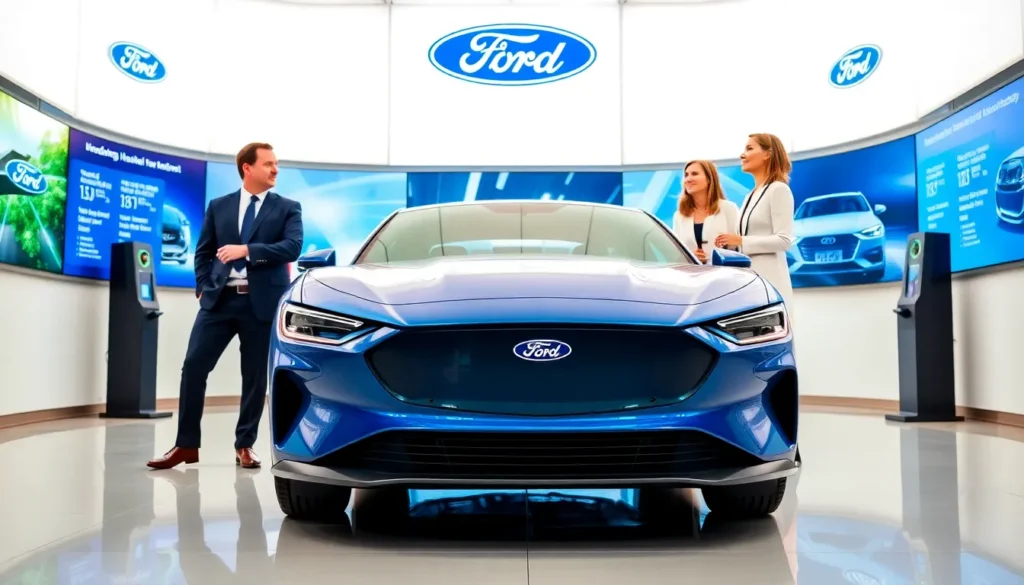Table of Contents
ToggleIn a world where gas prices seem to have a mind of their own, electric vehicles (EVs) are cruising in with a promise of savings and sustainability. But what if there was a way to make that transition even sweeter? Enter EV purchase incentives, the friendly little nudge from governments and organizations that make going green not just good for the planet but also for the wallet.
Imagine getting cash back just for swapping out your gas guzzler for a sleek, silent ride. It’s like finding money in your winter coat pocket, only this time, it’s a reward for helping save the planet. With various rebates, tax credits, and perks up for grabs, now’s the perfect time to plug into the electric revolution and drive away with both savings and style.
Overview of EV Purchase Incentives
EV purchase incentives play a crucial role in encouraging consumers to consider electric vehicles. These incentives take various forms, such as federal tax credits, state rebates, and local grants. Financial benefits significantly reduce the initial cost of purchasing an electric vehicle, making them more accessible to a broader audience.
Federal tax credits for electric vehicles can reach up to $7,500, depending on the make and model of the vehicle. Several states offer additional incentives, which can range from $1,000 to $5,000, further enhancing savings for buyers. Local utility companies also participate by providing rebates or reduced electricity rates for EV charging during off-peak hours.
In some areas, consumers enjoy additional perks like access to carpool lanes or exemption from certain tolls. These advantages not only enhance the overall driving experience but also present an opportunity to save on commuting costs. EV buyers often benefit from lower maintenance costs and decreased fuel expenditures, contributing to long-term savings.
Specific financing options exist for those who choose to lease or purchase an electric vehicle. Many auto manufacturers provide promotional loan terms that can further reduce monthly payments. Additionally, trade-in options for older gas-powered vehicles may be available, allowing consumers to boost their savings.
Government programs across various regions aim to transition consumers to electric vehicles. These initiatives support environmental goals by driving down greenhouse gas emissions, aligning with global sustainability efforts. Awareness of EV purchase incentives can greatly influence a consumer’s decision, making the switch to electric vehicles an attractive option.
Types of EV Purchase Incentives
EV purchase incentives come in several forms, each aimed at making electric vehicle ownership more appealing. Understanding these incentives helps consumers maximize their savings while contributing to a more sustainable future.
Federal Incentives
Federal incentives for electric vehicles include tax credits that can amount to up to $7,500. Many consumers qualify for this credit based on their tax liabilities, making it a significant financial benefit. To access these incentives, buyers must purchase eligible EV models that comply with specific requirements set by the IRS. Manufacturers often limit credits based on the number of vehicles sold, influencing consumer choices.
State Incentives
State incentives offer additional financial support that varies across the United States. Rebates typically range from $1,000 to $5,000, depending on the state’s policies and funds allocated for EV promotion. Some states also provide access to low-interest loans and grants, further easing the purchase process. Programs differ significantly, so potential buyers must check their state’s energy office or transportation department for the latest offerings.
Local Programs
Local programs enhance incentives through grants and rebates specific to municipalities. Certain cities have implemented their own financial aid, designed to promote green transportation options. Many local governments provide incentives for charging infrastructure installation, benefiting both residential and commercial properties. Residents can also explore programs that offer benefits like free parking or access to carpool lanes, making EV ownership even more attractive.
Impact of EV Purchase Incentives
EV purchase incentives significantly influence both the environment and the economy. By providing financial support, these incentives accelerate the transition to electric vehicles.
Environmental Benefits
Reducing greenhouse gas emissions plays a crucial role in combating climate change. Incentives promote the adoption of EVs, which produce zero tailpipe emissions. Lower city pollution levels contribute to improved air quality. Enhanced adoption of EVs leads to decreased dependence on fossil fuels. Supporting renewable energy sources like wind and solar creates a sustainable energy ecosystem. Communities benefit from healthier living conditions and reduced environmental degradation.
Economic Benefits
Cost savings from EV incentives can be substantial. A federal tax credit up to $7,500 greatly reduces the purchase price of electric vehicles. State rebates add an additional $1,000 to $5,000, making EVs more affordable for consumers. Lower fuel and maintenance costs translate into long-term savings. The transition to electric vehicles supports job creation in the green technology sector. Local economies gain from increased investments in EV infrastructure, fostering sustainable development.
Challenges and Limitations
The adoption of electric vehicle (EV) purchase incentives faces several challenges, impacting their effectiveness in encouraging widespread use of EVs.
Eligibility Requirements
Eligibility requirements for incentives often complicate access for potential buyers. Federal tax credits typically hinge on vehicle price and battery capacity, making only certain models eligible. State incentives vary widely, with some states imposing income limits while others focus on vehicle types. Local programs might have unique criteria that can confuse consumers. Prospective buyers should ensure they understand these conditions before pursuing incentives to avoid disappointment.
Funding Shortages
Funding shortages often limit the availability of EV purchase incentives. Federal budget constraints can lead to reduced tax credits when demand exceeds projections. State and local programs may face similar challenges, resulting in funding caps that restrict the number of eligible applicants. Such limitations can result in delays for consumers looking to benefit from these programs or entirely eliminate certain incentives. Consequently, it’s crucial for potential EV buyers to stay informed about current funding status to make well-timed purchasing decisions.
The landscape of electric vehicle purchase incentives is evolving rapidly. As consumers become more aware of the financial and environmental benefits, these incentives play a crucial role in driving adoption. With various federal, state, and local programs available, potential buyers can significantly reduce their initial investment in EVs.
While challenges like eligibility requirements and funding limitations exist, staying informed can empower consumers to make the most of these opportunities. Embracing electric vehicles not only leads to personal savings but also contributes to a cleaner and more sustainable future. The transition to EVs is more than a trend; it’s a step toward a greener economy and a healthier planet.




